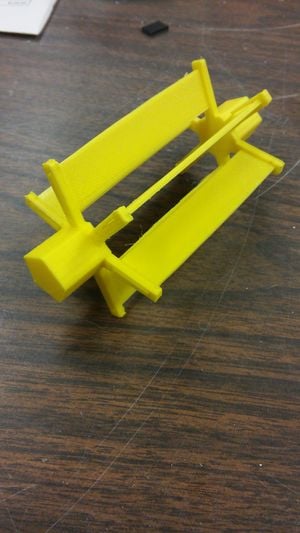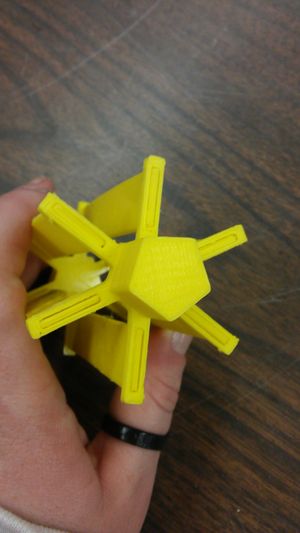
This is a cross-flow turbine,[1] essentially a water wheel turned by naturally flowing water to produce energy. Unlike a dam, or a mill wheel this is very small, more used in smaller streams and such. This provides energy without the cost of fuel and the only time and energy used to work on it is set up and very occasional maintenance. This is used in developing areas around the world because it's much cheaper and less time consuming. This design takes it to the next level where the material costs of the wheel itself are significantly reduced using 3D-printing.
Bill of Materials[edit | edit source]
- PLA or ABS Filament (1.75mm)
- All of the STL files and the SCAD files are here.
- Plastic Epoxy for better blade adhesion.
- Hook up to actually generate power
Tools needed[edit | edit source]
- MOST Delta RepRap or similar RepRap 3-D printer
- Knife/Exacto Knife
Skills and knowledge needed[edit | edit source]
- 3D-printing
Technical Specifications and Assembly Instructions[edit | edit source]
- Slide the blades into the slots so the wheel handles are facing out.
- if friction isn't sufficient to hold the blades then add a small amount of epoxy onto the inside of the wheel on the blades for more secure fit.

Common Problems and Solutions[edit | edit source]
- Poorly fitting blades, or broken wheel spokes are both fixable with a small amount of epoxy
Cost savings[edit | edit source]
- The mini wheel is about $0.30
- Cost saving really depend on the size of the wheel.
- Some micro-turbine plants can cost up to $20000.[2]
References[edit | edit source]
- ↑ Wikipedia: Cross-flow turbine Available: http://en.wikipedia.org/wiki/Cross-flow_turbine
- ↑ Wikipedia: Micro Hydro Available:http://en.wikipedia.org/wiki/Micro_hydro